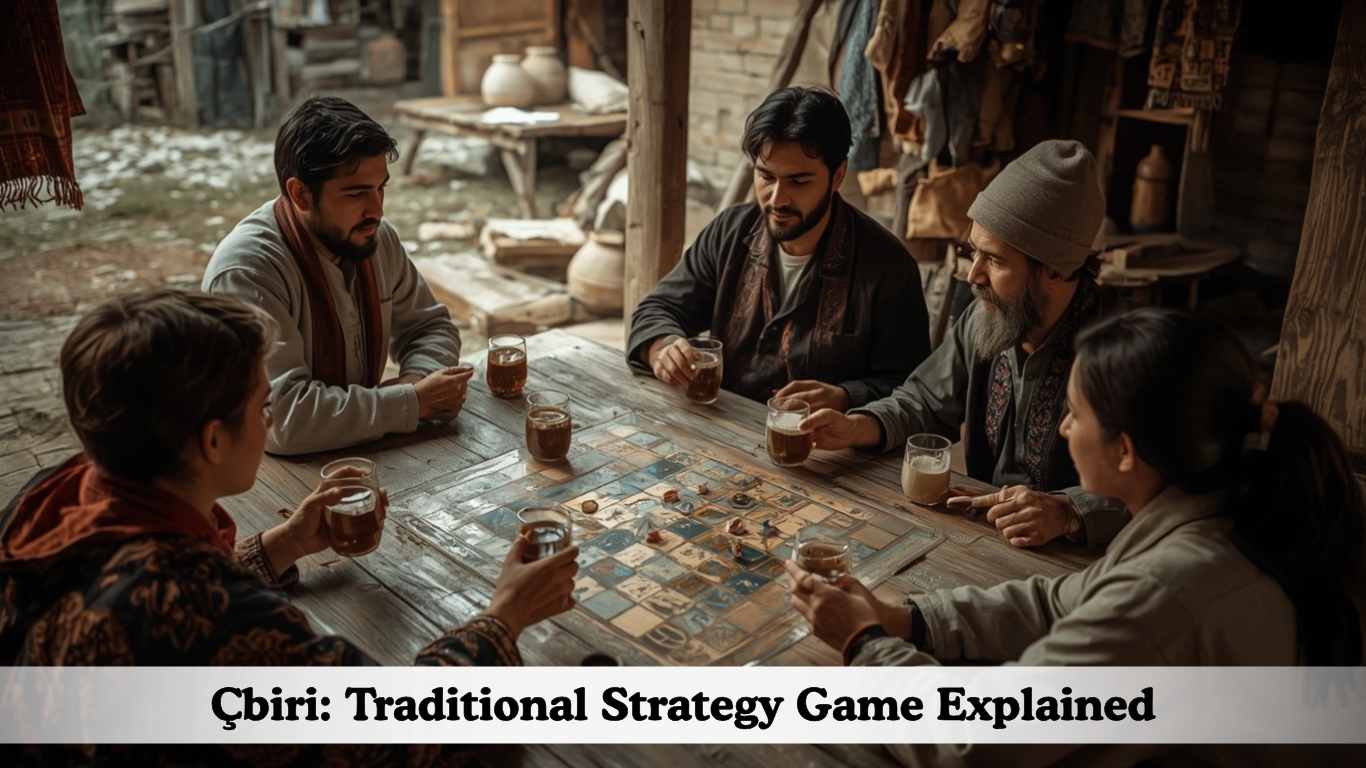Have you ever stumbled upon a game that not only entertains but also offers a peek into rich cultural heritage? If you haven’t yet discovered Çbiri, you’re in for a treat. This traditional strategy game is more than just a pastime; it’s an engaging blend of skill, history, and community bonding. With roots deeply embedded in various cultures, Çbiri has captivated players for generations. Whether you’re new to the world of board games or an avid strategist seeking something fresh, this ancient gem promises hours of enjoyment.
So grab your friends and family! It’s time to dive into the fascinating world of Çbiri—a game that invites everyone to test their wits while learning about its unique backstory and significance. Let’s explore what makes this traditional strategy game such an enduring favorite across cultures!
What Is Çbiri?
Çbiri is a captivating traditional strategy game that has been enjoyed by countless players across generations. Known for its intricate gameplay and rich cultural roots, this game often draws people in with its blend of skill and chance. It’s played on a board, featuring unique pieces that have their own roles and movements, making each match feel fresh.
The game’s primary objective revolves around outsmarting your opponent while protecting your own pieces. Players strategize, anticipate moves ahead, and adapt as the game unfolds. This blend of tactics keeps you engaged from start to finish.
What makes Çbiri truly special is how it brings people together. Families gather around the board during evenings or holidays to enjoy friendly competition and share stories. It’s more than just a game; it’s an experience that fosters connections among friends and loved ones.
While modern games often rely on flashy graphics or complex rules, Çbiri stands out with its simplicity yet deep strategic elements. Every move counts, creating tension as players navigate through challenges posed by their opponents.
If you’re looking for an enjoyable way to sharpen your mind while bonding with others, Çbiri offers all that—and so much more! Its charm lies in both the challenge it presents and the joy it brings when played together.
The Origins and History of Çbiri
Çbiri has roots that stretch deep into history, tracing back to ancient civilizations. This traditional strategy game is believed to have originated in Central Asia and gained popularity among various nomadic tribes. Over the centuries, it evolved as a means of entertainment and mental exercise.
The game likely spread along trade routes, adapting with each culture it encountered. Different regions put their unique spin on the rules and gameplay mechanics. This adaptability contributed to its enduring appeal across generations.
Historically, Çbiri wasn’t just a pastime; it held significant value in fostering community ties. Gatherings often featured intense matches that drew spectators eager to support local players. These events became social hubs where stories were shared, and traditions passed down.
Throughout its evolution, Çbiri has reflected the values of strategic thinking and patience cherished by many societies. As war tactics and political strategies changed over time, so too did the game’s complexity and depth.
Today’s modern players may not realize how much cultural heritage lies behind each move they make on the board. Understanding this rich history can enhance one’s appreciation for çbiri—not merely as a game but as a legacy connecting past and present communities.
How Çbiri Is Played: Rules and Setup
Playing Çbiri is a delightful experience that combines strategy and social interaction. To get started, you need a special board and pieces, usually crafted from wood or durable plastic. The board typically has a grid pattern, while the pieces come in different colors representing each player.
Each player sets up their pieces on opposite sides of the board. The objective? Capture your opponent’s pieces or block their moves to gain an advantage. Players take turns moving one piece at a time, either horizontally or diagonally across the grid.
One unique rule is the ability to jump over opposing pieces. If you land on them, they are removed from play! This adds an exciting twist and encourages players to think two steps ahead while planning their strategies carefully.
Players must also pay attention to positioning because certain arrangements allow for more powerful moves later in the game. A well-placed piece can change everything!
Timing matters too; knowing when to attack versus when to defend can turn tides dramatically. As you dive deeper into Çbiri, you’ll discover countless tactics that make each match uniquely engaging and intellectually stimulating.
Strategy and Skill in Çbiri
Çbiri is more than just a game; it’s a battlefield of wits. Every move counts, and players must think several steps ahead to outsmart their opponent. The blend of strategy and skill makes each match unique, filled with unexpected twists.
To excel at Çbiri, one needs to develop a keen sense of foresight. It’s not just about reacting to your opponent’s moves but anticipating them. Understanding the strengths and weaknesses of your pieces can turn the tide in your favor. This strategic mindset is what separates novice players from seasoned veterans.
Skill also plays a crucial role in mastering Çbiri. Players often spend hours practicing intricate techniques that enhance their gameplay. Each piece has its own abilities, requiring precision and creativity when deploying them on the board.
Moreover, adapting strategies mid-game adds an exciting layer to Çbiri. When faced with unforeseen challenges or clever maneuvers by an opponent, being flexible can lead you back on track for victory.
Engaging with others who share this passion enriches the experience even further. Discussing tactics or analyzing past games fosters growth for everyone involved while keeping the spirit of camaraderie alive among enthusiasts.
Cultural Importance of Çbiri
Çbiri is more than just a game; it’s a cultural treasure. Rooted in tradition, this ancient strategy game brings people together across generations. Families gather around the board, sharing stories and laughter while fostering bonds that last a lifetime.
In many communities, Çbiri serves as an educational tool. It teaches critical thinking and problem-solving skills to children in a fun environment. The game’s strategic nature encourages players to think ahead, making decisions that can affect not only their gameplay but also their understanding of cooperation and competition.
The visual aspects of Çbiri are striking too. Beautifully crafted boards and pieces often reflect local artistry, showcasing traditional craftsmanship. This aesthetic appeal enhances the experience, creating an appreciation for art alongside strategy.
Moreover, playing Çbiri is often accompanied by music or storytelling traditions unique to each culture. These elements enrich the gaming experience and keep alive oral histories that might otherwise fade with time.
As modern technology encroaches on leisure activities, Čbiri stands strong as a reminder of simpler joys—face-to-face interaction without screens involved. Its enduring presence underscores its significance in preserving collective identity within communities worldwide.
Educational Value of Playing Çbiri
Playing Çbiri offers a treasure trove of educational benefits. At its core, the game sharpens critical thinking skills. As players strategize their moves and anticipate opponents’ actions, they develop the ability to think several steps ahead. This mental exercise fosters problem-solving capabilities that can be applied in real-life situations.
Additionally, Çbiri promotes social interaction and communication. Players often engage in discussions about strategies or rules during gameplay. These conversations help improve verbal skills and encourage teamwork as players must work together to navigate challenges presented by the game.
Another key aspect is patience and perseverance. Mastering Çbiri requires practice, which teaches players that success doesn’t come overnight. They learn valuable lessons about resilience when faced with setbacks on the board.
Moreover, playing Çbiri can enhance pattern recognition abilities. Players must identify formations and predict potential outcomes based on their opponent’s moves—skills that translate well into fields like mathematics or science.
This traditional game connects individuals with cultural heritage while also providing historical context through storytelling elements woven into gameplay. Each match becomes an opportunity to explore history while learning important life skills through fun and engaging interactions.
Preserving Çbiri in Modern Times
Çbiri is more than just a game; it’s a piece of cultural heritage that deserves our attention. In today’s fast-paced world, traditional games like Çbiri face the risk of being forgotten. Yet, there are passionate communities striving to keep it alive.
One way people are preserving Çbiri is through local tournaments and competitions. These events bring together players from various backgrounds to showcase their skills and foster camaraderie. They also serve as an excellent platform for teaching newcomers about the game’s rich history and rules.
Schools are another vital avenue for preservation. By incorporating Çbiri into extracurricular activities or physical education classes, educators can introduce young minds to this strategic game early on. It creates a bridge between generations while encouraging critical thinking among students.
Digital platforms have emerged as powerful tools too. Online forums and social media groups allow enthusiasts to share strategies, tips, and resources related to Çbiri. This digital presence not only connects players but also sparks interest in those who might be new to the game.
Community centers often host workshops focused on teaching Čbiri techniques or strategies specific to regional styles. These gatherings promote teamwork while instilling pride in one’s cultural traditions through engaging gameplay experiences.
How to Learn and Play Çbiri Today
Learning to play Çbiri today is easier than ever. With the rise of digital resources, you can find tutorials and gameplay videos online that break down the rules step by step. YouTube is a great place to start; just type in “Çbiri tutorial” and you’ll discover numerous guides created by enthusiasts who share their passion for the game.
If you’re more of an interactive learner, consider joining online forums or social media groups dedicated to Çbiri. Many players are eager to share tips, strategies, and even arrange virtual games. Engaging with others who love the game can provide insights that books or videos alone may not cover.
For those who prefer hands-on experience, seek out local gaming clubs or community centers that host traditional game nights. This way, you’ll meet other players willing to teach you the nuances of Çbiri while enjoying a fun atmosphere together.
Don’t forget about practice! Like any strategy game, your skills will improve over time as you play more frequently. Try playing against friends or family members before challenging seasoned players.
There are plenty of mobile apps designed to simulate Çbiri gameplay if you’re on-the-go. These allow you to refine your skills whenever it suits your schedule while keeping the essence of this engaging traditional game alive.
The Future of Çbiri
The future of Çbiri is bright, especially with the growing interest in traditional games. More people are seeking authentic experiences that connect them to history and culture. As communities rediscover this ancient game, there’s potential for a revival beyond local gatherings.
Technology plays an intriguing role here. With mobile apps and online platforms emerging, players can engage with Çbiri from anywhere in the world. Imagine joining a match against someone halfway across the globe! This digital connection could introduce new strategies and styles of play, enriching the experience even further.
Educational institutions are also beginning to recognize its value. Incorporating Çbiri into school curriculums could teach students about strategy, critical thinking, and cultural heritage all at once. It’s more than just a game; it becomes a tool for learning and engagement.
Social media can amplify this revival too. Platforms like Instagram or TikTok allow enthusiasts to share tips, tricks, and exciting matches with followers worldwide. A community around Çbiri can grow rapidly through these interactive channels.
As interest continues to build, tournaments may emerge on both local and international stages. Competitive events would not only showcase talent but also celebrate tradition while inspiring newer generations to pick up this captivating game.
Conclusion
Çbiri is more than just a game; it’s a bridge between generations. It invites players into an intricate world of strategy, skill, and cultural heritage. As we navigate through the complexities of modern life, taking time to play such traditional games can be grounding.
For those who might be new to Çbiri or are looking to reconnect with it after years away, there’s no better time than now. Local communities are beginning to recognize its value, offering workshops and events where enthusiasts gather. This not only keeps the game alive but also enriches social ties.
The future looks promising for Çbiri as technology evolves too. Online platforms and mobile apps could make it accessible even to younger audiences while maintaining its essence. With each move on the board, players keep history alive while crafting their own stories within this timeless game.
So why not grab some friends or family members? Dive into the captivating world of Çbiri today! Whether you’re strategizing your next move or sharing laughter over friendly competition, there’s something truly special about this traditional game that brings people together across cultures and ages.


